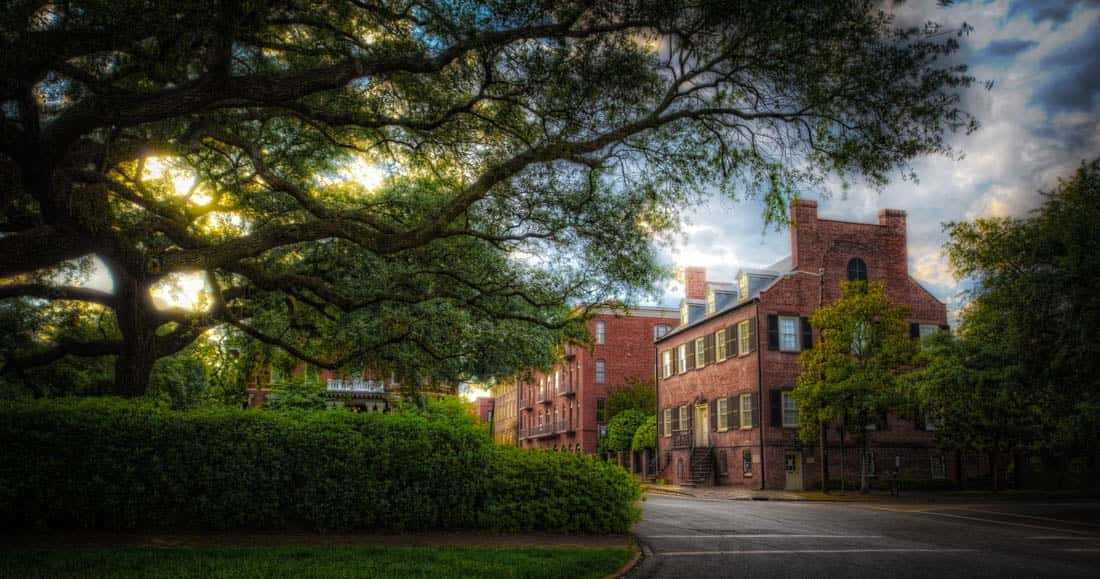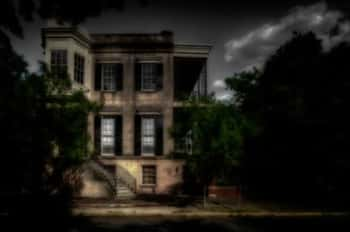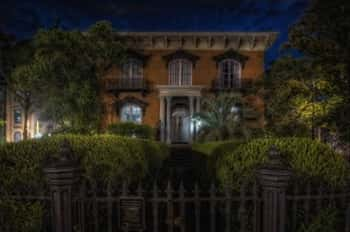For many people in the City of Savannah, the Davenport House on Columbia Square will always hold a special place in their hearts. The house is a historical gem, and a darling to fans of preservation. It was because of this love that the Davenport was actually the first house to be rescued by the Historic Savannah Foundation.
The Davenport's Federal-Style architecture and all around grandeur is just one side of its coin, as the historical importance of the Davenport is significant in telling the story of Savannah. And, thanks to the preservation efforts, many more generations will be able to appreciate the role that the house played in Savannah's history.
While the Davenport is admired for its historical importance, and architectural beauty, another particular aspect of the house to note comes in form of the supernatural. The Davenport is well known for the many lost souls which have taken up residence at the house over the years.

The historical home of the Isaiah Davenport house can be found on the northwest corner of Columbia Square, at 324 East State Street. These days the house is run as a museum, which was established in 1963 by the Historic Savannah Foundation.
The Federal-Style mansion was said to have been completed in 1820. But, it did not appear on tax rolls till a year later in 1821.
The home was built by the New Englander Isaiah Davenport, who became known as Savannah's Master Builder. Isaiah is a mysterious man in Savannah's history, as there are no known portraits or description of the allusive architect. And, much of his life was kept secret, a vague existence. If it wasn't for his immortal work, he may have been lost to history.
The first known example of Isaiah's work in Savannah is Laura's Cottage, which he constructed shortly after his arrival to the city in the year 1808. The craftsmanship of Laura's Cottage shows signs of the brilliance that would eventually bring him notoriety and great success.
With the absence of the yet invented power tools, the New Englander's skills were so superior that no other builder could possibly match up. He had reached legendary status in his field, enlarged partly due to his obsessive desire for perfection. It was this work ethic that created the standard, and simultaneously the staple tradition that other builders would follow in developing Savannah as the grand city we know today.
During his career, Isaiah constructed many awe-inspiring homes, not the least of which was his own house, his masterpiece. The Isaiah Davenport House is considered to be the pinnacle of Georgian architecture (ironic considering that Isaiah was from Rhode Island). His career has been a testament to an era when builders worked with their hand. Homes and buildings that have stood the test of time.
Isaiah was born in the scenic coastal town of Little Compton, Rhode Island, on November 3rd, 1784. As a young man, Isaiah apprenticed under a carpenter in New Bedford, Massachusetts. These formative years were crucial in the mastering of his craft. At the age of twenty-four, Isaiah, now comfortable in his abilities, decided to make the bold move of leaving the only life he had ever known. He packed up all of his belongings and made the journey to Savannah where grand adventures awaited him.
He arrived in Savannah in 1808, though official records do not show him as a resident of the city until the following year. Later that year, Isaiah met and married Sarah Rosamund Clark. The New Englander married the Georgia Peach at the Independent Presbyterian Church. The couple were madly in love, and had ten children together. However, only six of their kids survived childhood. Some believe the spirits of the four departed Davenport children still haunt the house to this very day.
Despite his personal losses, Isaiah would continue on with his work. Perhaps the reason he was so successful was that he had to immerse himself into his work to cope with grief. Besides, he still had a house full of children to provide for, certainly a difficult task in itself.
Along with the numerous private homes Isaiah constructed, he also worked as the go-to guy for the City of Savannah. He proudly served as a contractor for the city many times. Isaiah's most notable contribution to the city was his work in restoring Savannah's historic squares. He was again called upon after the Great Savannah Fire of 1820, where he was in charge of building temporary housing for the many displaced citizens.
Isaiah's eye for detail, and flawless work, eventually caught the attention of the federal government. He was contracted to build a Martello Tower on Tybee Island for coastal defense—a safety measure constructed to protect against any would-be attackers.
A man never content with his talent and the art he had created, Isaiah desired more. His partnership on city and federal projects further drove his aspirations. Isaiah became more involved with city politics, eventually throwing his hat into the political ring. Form 1817 to 1822, Isaiah served as a city alderman. As if that were not enough, he also became a firemaster for the wards of Greene and Columbia. Later, he became topped off his political and civil service career in becoming a constable for the Columbia Ward.
Sadly, like so many in Savannah during the 1800s, Isaiah fell victim to yellow fever. He died on October 16th, 1827, at just 43 years of age. Isaiah accomplished so much in so little time that it makes you wonder what else would he have achieved if given the gift of more years on this earth. His body was laid to rest at Colonial Cemetery for a spell before later being exhumed and interned in Laurel Grove Cemetery.
One month after Isaiah's death his tenth child was born, a boy named Dudley. Sadly, like his father Dudley would die young too. He died at the age of forty in 1867.
After Isaiah's passing, his wife, Sarah, in need of additional support, converted their Davenport home into a boarding house, as she was now a widow with six children to support. And, so she did. She and her children remained on the property until the year 1840.
Sarah was faced with a difficult decision, as she could no longer maintain her beloved house—the house in which her husband had poured his heart and soul. But, as the case was with everything, time will always come around. And, the time to sell her home had come. Sarah sold the Davenport House (in 1840) for nine thousand dollars to Benjamin Baynard and his family, who had arrived to Savannah from Hilton Head, South Carolina.
The Davenport House remained in the Baynard family for over a century. In the year 1955, the Davenport House was sold for the second time in its hundred and thirty-five years of existence. Over the years, the majestic Davenport House and the idyllic neighborhood surrounding the home deteriorated to the setting of a Stephen King novel.
Considered blighted, and ordered to be demolished by the city, the Davenport House found itself in need of mercy. A group of Savannahians keen on preservation united together with the purpose of saving the Davenport. And, save it they did. The group known as the Historic Savannah Foundation purchased the house (in 1955), as their first act of preserving the history of Savannah.
Later that year, the Historic Savannah Foundation turned the Davenport House into their headquarters, as well as an agency for family services. Seeing the promise that the Davenport still had, the foundation began the slow process of restoring the house. On March 9th, 1963, the foundation opened the first floor of the Davenport as a museum open to the public. As the renovation process continued to the upper levels of the house, the foundation opened up the entire house to the public and moving their headquarters to another building.
Decades later, in the mid-eighties, the foundation, wishing for the Davenport to meet professional standards as a museum, began the process of raising the proper funds to aid their new endeavor. Ten years later, they were finally able to start the new restorations. Their goal was to create an authentic experience for all visitors by incorporating period fixtures and furnishings that closely aligned with the style that was present in the era in which Isaiah Davenport departed in 1827.
For the Historic Savannah Foundation's excellent work, the Davenport House Museum was honored with the Preserve America Presidential Award in 2005. Five years later (in 2010) the Davenport was again honored. On this occasion they received the Georgia Governor's Award in the Humanities.
Whenever you have a house as old as the Davenport, you will usually find paranormal disturbances of some kind. Whether it's a shadowy figure lurking in the dark, or disembodied whispers of lost souls from the past. Souls desperate to tell their stories from years gone by. And, after all that's the point of a museum: to learn stories of the past.
While all dogs go to heaven, apparently the same can not be said for cats. Well, at least one cat. One of the most famous ghost stories associated with the Davenport House is not the lost soul of a person, but the curious spirit of a cat. This ghostly cat has been seen time and time again by those who have visited the Davenport. Most of these ghostly encounter of a feline kind usually occur during museum tours. These sighting of a wandering, Binx-esque cat (yes, that is a Hocus Pocus reference) transcend decades.
Visitors will often catch a glimpse of the cat as it darts from one room to another, as if he is trying to catch a supernatural mouse. Other people have spotted the cat sitting on the window sill, standing regal and watching people from his station. As though he serves as the guardian of the Davenport House. You may think that this is just some stray or house cat. But, as the folk who work at the museum will tell you, there is no living cat in the house.
So, what's going on—what are all these people seeing? Is it possible that they are mistaking something else for a cat? Maybe... One or two claims could easily be dismissed. But, these sightings have occurred on numerous occasions. Many times, spreading over years, people have described the cat they witness in a fairy descriptive manner, and in each account the cat is described identically.
Is this a ghost cat? Seems more probable than an immortal cat, protecting the black flame candle in effort to save the children of Salem from the Sanderson sisters, right? Besides, if humans can become ghosts, why not cats too? Usually, the reason why people refuse to crossover is because of unfinished business. What could be the unfinished business of a cat? I can see why Tom might stick around having never captured the allusive Jerry. But, this isn't a cartoon. So, what is this cat's reason? Maybe, the theory of Binx isn't so improbable at the end of the day. Maybe, the ghostly cat of the Davenport house is serving as its protector.
Not all of the ghost stories at the Davenport House belong to the animal kingdom. Another famous ghost story at the house involves the spirit of a young girl. This ghostly young lady has frequently been seen roaming through the house and the gardens outside of the main residence. Like the cat, she also has been seen in the windows. Usually on the upper floors. It's been said that she looks down upon the street, on over the people who pass by; sometimes this includes people who are on ghost tours.
On at least one occasion this ghostly little girl has been seen by guests visiting the house on a day time tour. They noticed a girl, playing in the attic. After finding a docent, the house was searched for this little girl. She was then seen running outside, and then she seemingly vanished into thin air.
Who was this little girl? Could she have been one of the Davenport children? It is true that four of the ten Davenport children died at a young age. But, as mentioned before, the Davenport also served as a boarding house, and at times was home to as many as ten different families at once. Surely one of these families had a young daughter with them, and Yellow Fever was claiming casualties every day. It is very likely that a child fell ill while living at the Davenport during its reign as a boarding house, and later succumbed to the disease.
The truth behind the ghost girl at the Davenport may never come to light. But, we should all be respectful of her spirit, as her paranormal being almost certainly is the result of tragedy.
During the month of October, the Davenport House Museum offers visitors a chance to experience what life was like in the 1820s. This experience is not a haunted attraction—it's meant to educate people about the Yellow Fever epidemic. The Davenport handles and discusses the outbreak in a truly personal way.
The museum showcases the issue surrounding the epidemic respectfully, and tells the stories of the many lives that were lost in the nineteenth century, especially those souls in the coastal regions in America. Savannah, obviously, was not excluded from this horrid plague, thus the reasoning to why the Davenport recreates the setting of this ominous era. And, it is indeed important to remember the historic nature of this biblical-esque curse.
The 1820 recreation of the yellow fever outbreak also shares the story of the heroic Mary Lavinder. Mary was the first women in the State of Georgia to become a physician. And, it was during the epidemic, in which she served. She was a tireless worker who never wavered from her mission of trying to save the lives of the people of Savannah. Dr. Lavinder's work is as historic as the Davenport House itself, and perhaps more deserving of notoriety.
The Davenport House Museum is located on Columbia Square, at 324 East State Street. It is diagonal from the haunted Kehoe House Bed and Breakfast.
If you would like to learn more about the Davenport House and the ghosts which are often seen there, take Ghost City's All-Ages Grave Tales Ghost Tour. This ghost tour stops near the Davenport House on almost every tour.

One of Savannah's haunted historic homes

Savannah's most infamous haunted house

Savannah's most iconic haunted house